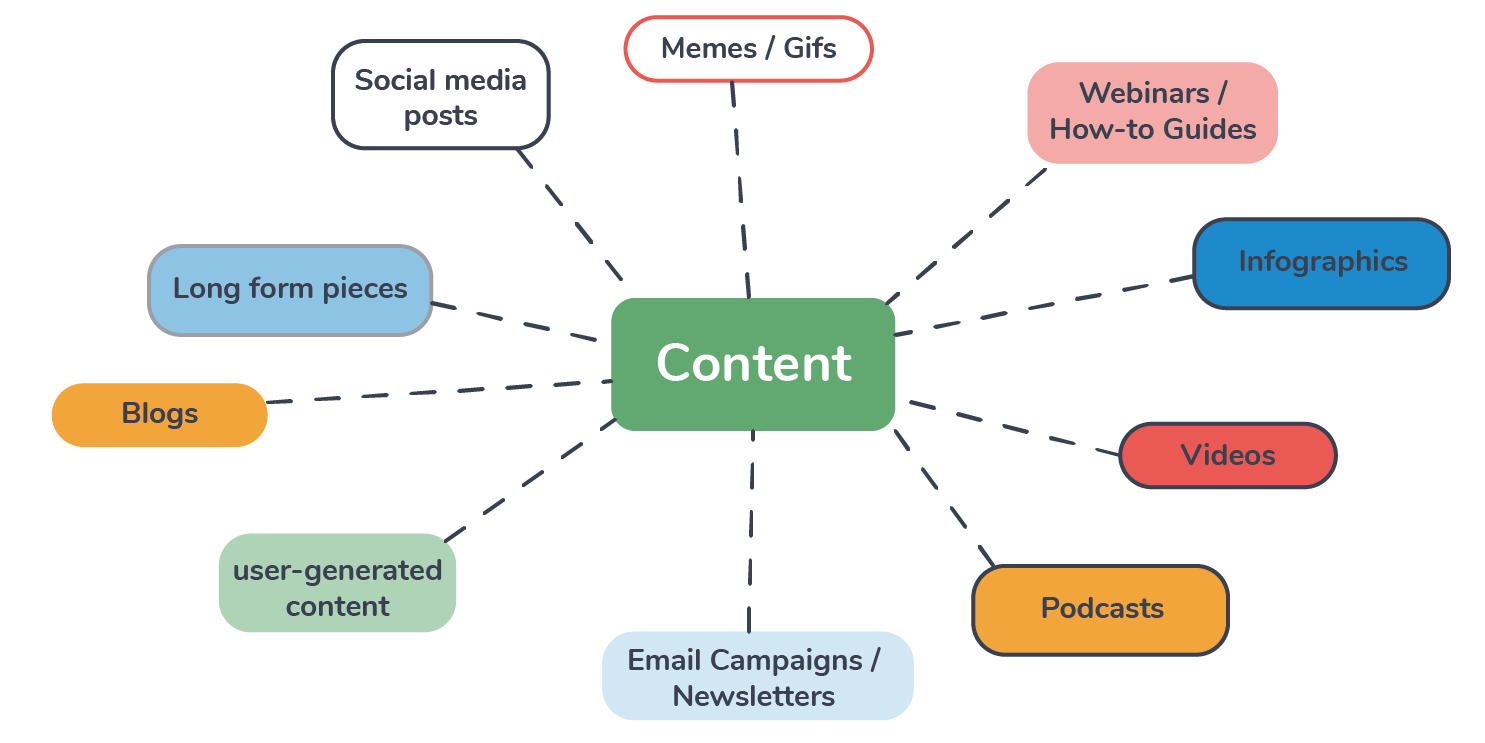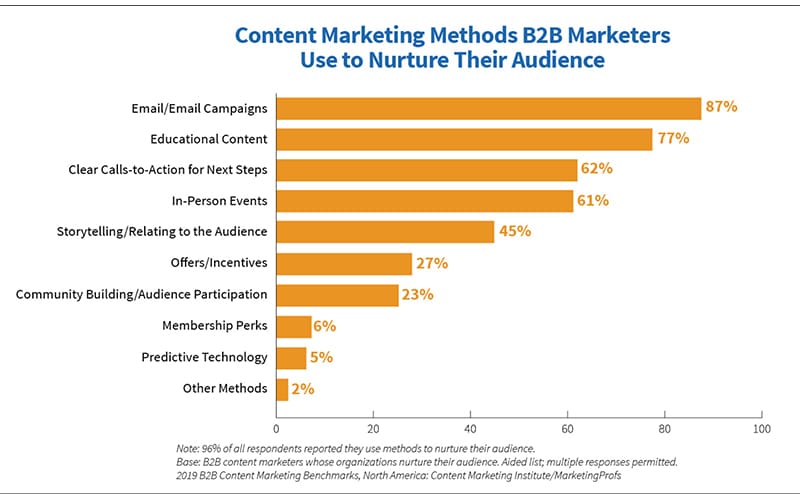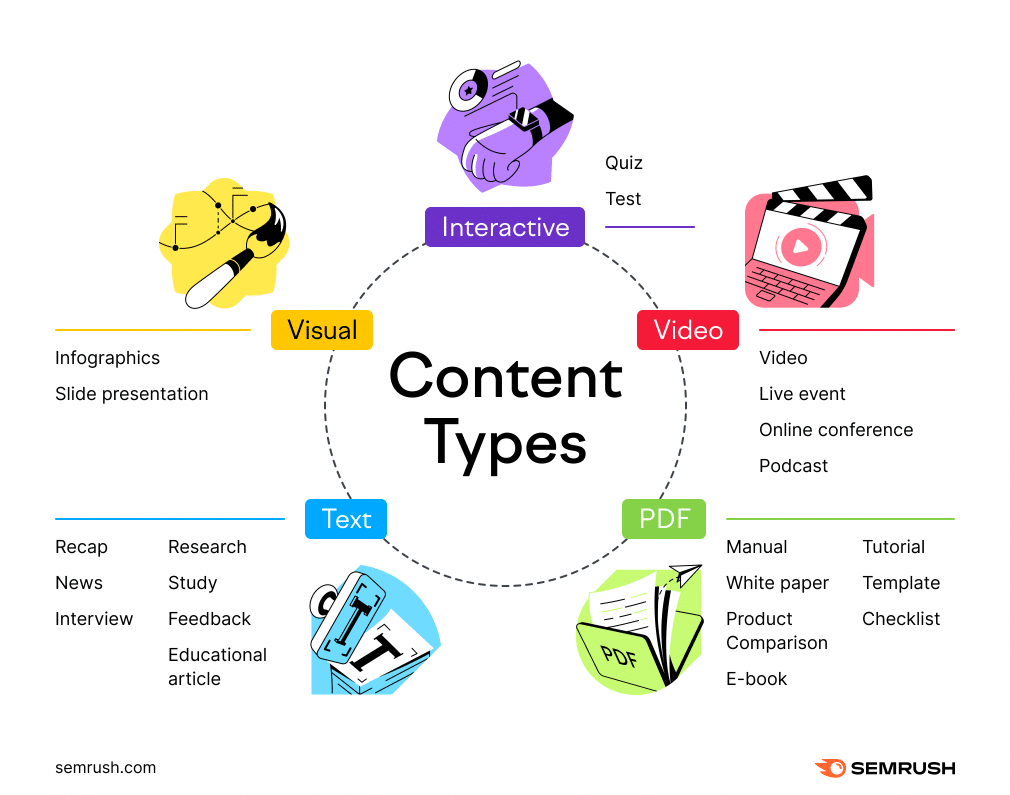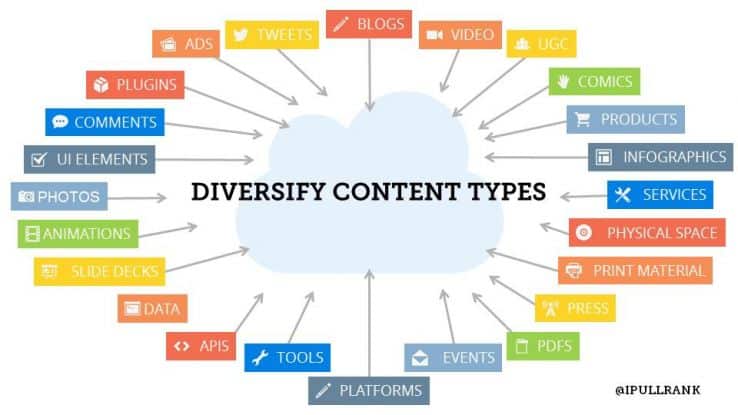In the digital era, your website acts as the face of your business and is often the first point of interaction between you and your potential customers. The content on your website doesn’t just convey your brand message, but it also plays a pivotal role in guiding visitors along the buyer’s journey, eventually leading them to conversion. Conversion, be it in terms of sales, sign-ups, or engagement, is the ultimate goal of most websites. However, achieving a high conversion rate is often easier said than done, especially with the ever-evolving consumer preferences and the saturated online market.
Integrating a variety of content types on your website can significantly enhance the user experience, keep your audience engaged, and optimize the conversion pathway. Diverse content caters to different stages of the buyer’s journey and appeals to a broad spectrum of audience preferences. From informative blogs and insightful case studies to interactive quizzes and compelling testimonials, the right mix of content can provide value, build trust, and motivate action.
In this article, we will delve into 15 effective types of content that you can utilize on your website to enrich the user experience and drive higher conversion rates. Each content type has its unique advantages and can be tailored to meet the specific goals and target audience of your business.
By understanding and implementing these content forms strategically, you can create a more dynamic, user-centric website that not only attracts traffic but also nurtures leads and boosts conversions.
Articles
In the realm of SaaS marketing, articles serve as a linchpin in the strategy, constituting an indispensable element for successful endeavors. The world of technology and software is ever-evolving, and in this dynamic landscape, a well-crafted article plays a pivotal role in positioning a B2B SaaS brand as an industry leader.
First and foremost, articles enable SaaS companies to establish their thought leadership and authority in the field of technology. Through well-researched, informative, and engaging content, they can showcase their expertise, fostering trust and credibility among their target audience. In the competitive sphere of marketing for software solutions, this trust is the currency that drives brand loyalty and customer retention.
Moreover, articles offer a platform for SaaS brands to communicate the unique value propositions of their products or services. By crafting content that highlights the specific problems their software addresses and the benefits it delivers, companies can effectively educate potential clients. This educational aspect is paramount in B2B SaaS branding, as it helps potential customers understand how the software can meet their business needs.
Furthermore, articles are an invaluable tool for driving organic traffic and boosting SEO rankings. High-quality, keyword-optimized articles can attract potential clients actively searching for solutions in the SaaS market, ensuring that a brand remains visible and relevant in the highly competitive world of SaaS marketing.
Articles are the cornerstone of a robust SaaS marketing strategy, serving as a conduit for thought leadership, educational content, and increased online visibility. In the fast-paced realm of B2B SaaS branding, their importance cannot be overstated, as they help companies navigate the intricate landscape and stay ahead of the curve.
Guest Blog Posts
Guest blog posts emerge as an indispensable component of a strategic arsenal, offering multifaceted benefits that significantly enhance a brand’s presence and influence in the market. In the competitive landscape of marketing for software solutions, these guest contributions play a pivotal role in elevating B2B SaaS branding.
First and foremost, guest blog posts allow SaaS companies to tap into established networks and audiences within their niche. Collaborating with industry influencers or complementary businesses provides access to a wider and highly targeted audience, fostering brand recognition and credibility. By associating with respected figures, SaaS brands gain a seal of approval, bolstering their reputation in the market.
Furthermore, guest blogging facilitates the exchange of expertise and insights, demonstrating thought leadership within the SaaS industry. Sharing valuable knowledge and innovative perspectives through these posts not only educates the audience but also positions the brand as a go-to resource for solving complex software-related challenges. In the context of B2B SaaS branding, this is instrumental in building trust and authority.
Guest blog posts also offer a robust SEO advantage by generating backlinks from authoritative websites. This not only improves search engine rankings but also drives organic traffic, providing an effective means to boost online visibility in the competitive sphere of SaaS marketing.
Guest blog posts are an integral pillar of an effective SaaS marketing strategy. They empower SaaS brands to expand their reach, demonstrate thought leadership, and gain valuable backlinks, all of which are critical for thriving in the world of B2B SaaS branding.

How-To Guides
How-to guides are an essential and strategic component of any successful SaaS marketing strategy. In the competitive landscape of marketing for software solutions and B2B SaaS branding, these guides serve as powerful tools for attracting and retaining customers.
Firstly, how-to guides provide immense value to the target audience by offering step-by-step instructions on how to effectively use a SaaS product. In a complex and ever-evolving industry like SaaS, potential customers often seek detailed guidance to maximize the benefits of a software solution. By providing these guides, SaaS companies demonstrate their commitment to customer success and foster trust among their client base.
How-to guides establish a brand as an authority within its niche. When a SaaS company consistently delivers high-quality guides that address specific pain points and offer practical solutions, it positions itself as a go-to resource for industry insights. This thought leadership is invaluable in the realm of B2B SaaS branding, as it helps build credibility and attract a loyal customer base.
How-to guides contribute significantly to a brand’s content marketing strategy. They can be leveraged across various channels, from blog posts and email marketing to social media and webinars, providing a versatile content asset that engages and educates the target audience.
In conclusion, they enhance customer satisfaction, establish thought leadership, and fuel content marketing efforts, all of which are crucial in navigating the competitive landscape of marketing for software solutions and achieving successful B2B SaaS branding.
Define your target audience personas using AI with Frictionless.
Effective marketing and sales rely on knowing your audience inside and out. Leverage our free AI persona builder to get an unbiased view of your targets.
Playful Images
Unique images play a vital role in a comprehensive SaaS marketing strategy in the competitive arena of marketing for software solutions. These visuals serve as powerful assets that can captivate, inform, and persuade potential customers, ultimately driving the success of a SaaS brand.
Firstly, unique images help SaaS companies convey complex ideas and features in a visually appealing and easily digestible format. In an industry where conveying the value and functionality of software can be challenging, compelling images can simplify the message and make it more accessible to a wider audience. This is especially crucial for engaging and retaining the attention of prospective clients.
Moreover, visual content, including unique images, tends to be more shareable and memorable on social media and other marketing channels. A striking image can instantly grab the viewer’s attention and encourage them to engage with the content, leading to increased brand visibility and potential virality.
Furthermore, in the world of SaaS marketing, where user interfaces and user experiences are paramount, unique images can showcase the product’s aesthetics and usability. High-quality visuals can help potential customers envision how the software will fit into their workflow, fostering a sense of connection and trust.
Images are imperative to a successful SaaS marketing strategy as they simplify complex concepts, enhance engagement, and contribute to a brand’s overall visual identity. In the fiercely competitive realm of marketing for software, these images serve as a powerful tool for conveying the value and appeal of SaaS products to a discerning audience.
Infographics
Visually engaging and data-rich graphics play a pivotal role in conveying complex information succinctly and persuasively.
Infographics have the power to distill intricate software features and benefits into easily digestible snippets of information. In an industry where understanding the value proposition is critical, infographics provide a visually compelling way to showcase key functionalities, making it simpler for potential customers to grasp the advantages of a SaaS product.
Moreover, infographics are highly shareable and promote virality on social media and other digital platforms. Their visually appealing nature encourages users to share and engage with the content, amplifying a SaaS brand’s reach and visibility within the competitive landscape of SaaS marketing.
Furthermore, these graphics can establish a SaaS company as a thought leader in the industry. By presenting data-driven insights and trends in a visually compelling manner, infographics demonstrate expertise and authority, thereby building trust and credibility with the target audience.
Infographics simplify complex information, enhance shareability, and establish thought leadership in the field of marketing for software. In the competitive arena of B2B SaaS branding, infographics are a powerful tool to capture and retain the attention of discerning customers while effectively conveying the value of SaaS solutions.

Video and Animation
Video and animation are indispensable elements of a robust SaaS marketing strategy. These dynamic visual mediums offer compelling advantages for engaging, educating, and converting potential customers.
Firstly, video and animation breathe life into complex software concepts, making them more accessible and engaging. In an industry characterized by intricate technical details, these mediums allow SaaS companies to convey their product’s functionality and value proposition in a visually compelling and user-friendly manner. This enhances understanding and aids in the decision-making process for potential clients.
Video and animation have the unique ability to evoke emotions and tell stories effectively. They can showcase real-world use cases, customer success stories, and the human side of a SaaS brand, fostering connections and trust with the audience. This emotional engagement is crucial in B2B SaaS branding, where building lasting customer relationships is paramount.
These visual mediums are highly shareable and have a proven track record of driving engagement on social media and other digital platforms. Videos and animations are more likely to be shared and can go viral, amplifying a SaaS brand’s reach and impact in the competitive sphere of SaaS marketing.
Illustrations & Data Visualization
Illustrations and data visualization are integral components of a comprehensive SaaS marketing strategy, particularly in the competitive landscape of marketing for software solutions and B2B SaaS branding. These visual elements serve as powerful tools for conveying complex information, enhancing engagement, and establishing credibility.
Illustrations and data visualization can simplify intricate software concepts and data sets, making them more accessible and comprehensible to the audience. In an industry where technical details can be overwhelming, these visuals provide a user-friendly approach to explaining product features, benefits, and performance metrics. This simplification aids potential customers in making informed decisions about SaaS solutions.
Illustrations and data visualization add a layer of creativity and aesthetics to SaaS marketing efforts. They transform dry statistics and technical information into visually appealing content that captures the audience’s attention. This creative approach helps brands differentiate themselves in the competitive world of B2B SaaS branding, making their messaging more memorable and impactful.
These visuals enhance the brand’s authority and thought leadership. By presenting data-driven insights and industry trends through effective visual storytelling, SaaS companies demonstrate their expertise and credibility. This thought leadership fosters trust among potential customers, a crucial factor in successful SaaS marketing.
Customer Testimonials
Customer testimonials are imperative to an effective SaaS marketing strategy. These authentic endorsements from satisfied customers carry immense weight and offer several compelling benefits for SaaS companies.
First and foremost, customer testimonials provide social proof of a SaaS product’s effectiveness and reliability. In an industry where trust and credibility are paramount, hearing directly from other businesses or individuals who have experienced positive results with the software can significantly influence potential customers. These testimonials validate the claims made in marketing materials and reassure prospects that the investment in the software is a sound decision.
Testimonials offer real-world examples of how the SaaS product addresses specific pain points and delivers tangible value. They provide concrete use cases and success stories that resonate with potential customers facing similar challenges. This relatability helps in building a deeper connection between the product and its target audience.
Customer testimonials contribute to building a sense of community and trust around the brand. They demonstrate that the SaaS company values and prioritizes its customers’ experiences, fostering loyalty and long-term relationships. In the competitive landscape of SaaS marketing, where customer retention is vital, these testimonials can be instrumental in retaining existing clients.
Case Studies
Case studies are indispensable assets within a comprehensive SaaS marketing strategy, especially in the context of marketing for software solutions. These in-depth narratives provide a compelling means to showcase a SaaS product’s real-world impact, benefits, and effectiveness.
Case studies serve as persuasive tools for conveying how the software addresses specific challenges faced by businesses. By presenting detailed problem-solving scenarios, they offer a comprehensive view of how the SaaS product can improve operations, increase efficiency, and drive growth.
Case studies provide valuable insights into the experiences of satisfied customers. They go beyond mere testimonials by offering a holistic understanding of the customer’s journey, from initial pain points to the successful implementation and outcomes achieved with the SaaS solution. This narrative storytelling engages potential customers on an emotional level, making them more likely to identify with the challenges and solutions presented.
Case studies substantiate a SaaS brand’s claims and build trust and credibility. They demonstrate that the product delivers on its promises and can be a valuable asset to businesses in various industries. In an era where data-driven decision-making is the norm, these evidence-based narratives offer quantifiable results and impact, further bolstering the SaaS product’s reputation and desirability.
Memes
Who doesn’t love a good meme?
Memes, though often associated with humor and internet culture, can play a strategic role in SaaS marketing. These light-hearted and shareable visuals provide a unique opportunity to engage with the target audience and inject personality into a typically technical and serious industry.
In the competitive landscape of SaaS marketing, memes offer a refreshing break from the norm. They can be used to create a sense of relatability and resonate with the audience on a personal level. By incorporating humor or clever references into SaaS-related content, memes can captivate the attention of potential customers and make the brand more memorable.
Memes have the potential to go viral, exponentially increasing a SaaS brand’s reach and visibility. When well-crafted and aligned with the brand’s messaging, memes can encourage users to share and engage with the content, leading to increased brand awareness and potential customer acquisition.
Memes allow SaaS companies to showcase their agility and cultural relevance. By participating in current trends or conversations through meme creation, brands can position themselves as modern and in touch with the digital age.

Email Newsletters
Email newsletters are an important piece of a well-rounded SaaS marketing strategy, particularly within the context of marketing for software solutions. These targeted and personalized messages offer a direct and effective means of nurturing leads, retaining customers, and staying top-of-mind in the competitive landscape of SaaS marketing.
Email newsletters provide a valuable channel for delivering relevant content and updates to a SaaS company’s audience. They enable the sharing of informative articles, product announcements, and educational resources, fostering engagement and keeping subscribers informed about the latest developments in the software industry.
Email newsletters contribute to building a sense of community and trust around the SaaS brand. Consistent communication through newsletters reinforces the brand’s presence and demonstrates its commitment to customer success. This trust is pivotal in retaining and upselling existing customers in the fiercely competitive world of marketing for software.
Additionally, newsletters offer a platform for segmenting and targeting specific audience groups. By tailoring content to the unique needs and interests of different subscriber segments, SaaS companies can deliver highly relevant messages that resonate with recipients. This personalization enhances the effectiveness of email campaigns, resulting in higher open and click-through rates.
E-Books
These downloadable resources provide a unique opportunity to showcase expertise, educate the audience, and generate leads in the landscape of SaaS marketing.
E-books serve as powerful tools for establishing a SaaS brand as a thought leader within the industry. By offering in-depth, well-researched content, these resources demonstrate expertise and authority, positioning the company as a trusted source of information and solutions for complex software-related challenges.
E-books offer a means to educate potential customers about the value and functionality of SaaS products. They can provide comprehensive guides, best practices, and case studies, helping prospects understand how the software can address their specific business needs. In the fast-paced world of marketing for software, this educational aspect is crucial for guiding informed decision-making.
E-books are effective lead generation assets. By offering valuable content in exchange for contact information, SaaS companies can build a database of qualified leads interested in their products or services. This facilitates targeted marketing and nurturing campaigns, ultimately increasing the likelihood of conversion.
Lists
These succinct and organized compilations of information offer a powerful means to engage, inform, and captivate the target audience in the competitive landscape of SaaS marketing.
Lists are highly effective in capturing the attention of potential customers who are seeking quick and easily digestible information. In an industry where technical details and features can be overwhelming, lists provide a structured and accessible format for conveying key points, benefits, or best practices related to a SaaS product.
They cater to the human preference for simplicity and organization. They distill complex concepts or ideas into manageable, numbered steps or bullet points, making it easier for the audience to absorb and retain information. This simplification aids in conveying the value proposition of a software solution effectively.
Lists serve as valuable resources for SEO and content marketing efforts. Search engines often favor list-type articles due to their readability and user-friendliness. This makes lists an essential tool for improving a SaaS brand’s online visibility and attracting organic traffic in the competitive landscape of marketing for software

Audit Your Brand Messaging
Brand Positioning Audit Guide
Your Brand & Positioning are fundamental to content that you create.
Podcasts
Audio-based content pieces provide a unique avenue for SaaS companies to engage, educate, and connect with their target audience in the competitive landscape of SaaS marketing.
Podcasts offer a personal and intimate way to convey valuable insights and industry expertise. They enable SaaS brands to showcase their thought leadership, share success stories, and discuss emerging trends, establishing a genuine connection with the audience. In the world of marketing for software, this personal touch can set a brand apart and build lasting customer relationships.
Podcasts provide a versatile platform for delivering content in a convenient and accessible format. Audiences can listen to podcasts during commutes, workouts, or downtime, making them a convenient way to consume information about SaaS products and industry developments. This accessibility enhances engagement and extends a brand’s reach.
Product Reviews
Assessments and evaluations from real users provide invaluable insights, build trust, and influence purchasing decisions in the competitive landscape of SaaS marketing.
Product reviews serve as authentic endorsements of a SaaS solution’s capabilities and performance. They offer potential customers an unbiased perspective on the software’s effectiveness, ease of use, and suitability for specific business needs. In an industry driven by trust and credibility, positive reviews act as powerful testimonials that can sway prospects toward making a purchase.
Reviews contribute to building a sense of community and transparency around the SaaS brand. They demonstrate that the company values and prioritizes customer feedback, fostering loyalty and long-term relationships. In the competitive world of marketing for software, where customer retention is vital, these reviews can be instrumental in retaining and upselling existing clients.
Product reviews are instrumental in improving and fine-tuning a SaaS product. Constructive feedback from users can pinpoint areas of improvement, allowing the company to enhance the software’s features and address pain points effectively. This iterative process helps maintain a competitive edge and ensures customer satisfaction.
Written by: Tony Zayas, Chief Revenue Officer
In my role as Chief Revenue Officer at Insivia, I am at the forefront of driving transformation and results for SaaS and technology companies. I lead strategic marketing and business development initiatives, helping businesses overcome plateaus and achieve significant growth. My journey has led me to collaborate with leading businesses and apply my knowledge to revolutionize industries.
